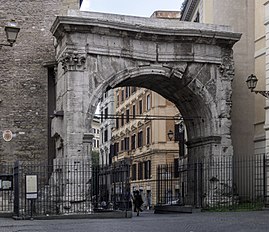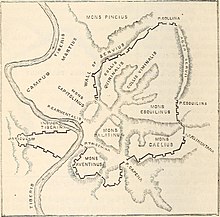
Servius Tullius was the legendary sixth king of Rome, and the second of its Etruscan dynasty. He reigned from 578 to 535 BC. Roman and Greek sources describe his servile origins and later marriage to a daughter of Lucius Tarquinius Priscus, Rome's first Etruscan king, who was assassinated in 579 BC. The constitutional basis for his accession is unclear; he is variously described as the first Roman king to accede without election by the Senate, having gained the throne by popular and royal support; and as the first to be elected by the Senate alone, with support of the reigning queen but without recourse to a popular vote.
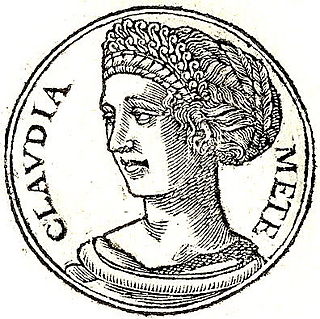
Clodia, nicknamed Quadrantaria, Nola, Medea Palatina by Cicero, and occasionally referred to in scholarship as Clodia Metelli, was one of three known daughters of the ancient Roman patrician Appius Claudius Pulcher.
The Caelian Hill is one of the famous seven hills of Rome.

The (second) Battle of Mantinea or Mantineia was fought on 4 July 362 B.C. between the Thebans, led by Epaminondas and supported by the Arcadians and the Boeotian league against the Spartans, led by King Agesilaus II and supported by the Eleans, Athenians, and Mantineans. The battle was to determine which of the two alliances would dominate Greece. However, the death of Epaminondas and his intended successors would cost Thebes the military leadership and initiative to maintain Theban supremacy in the region. Similarly, the Spartans were weakened by yet another defeat and loss of troops. Epaminondas' death coupled with the impact on the Spartans of yet another defeat weakened both alliances, and paved the way for Macedonian conquest led by Philip II of Macedon.
Hipponicus III was an Athenian military commander. He was the son of Callias II of the deme Alopece and Elpinice of Laciadae. He was known as the "richest man in Greece".

The Servian Wall is an ancient Roman defensive barrier constructed around the city of Rome in the early 4th century BC. The wall was built of volcanic tuff and was up to 10 m (33 ft) in height in places, 3.6 m (12 ft) wide at its base, 11 km (6.8 mi) long, and is believed to have had 16 main gates, of which only one or two have survived, and enclosed a total area of 246 hectares. In the 3rd century AD it was superseded by the construction of the larger Aurelian Walls as the city of Rome grew beyond the boundary of the Servian Wall.
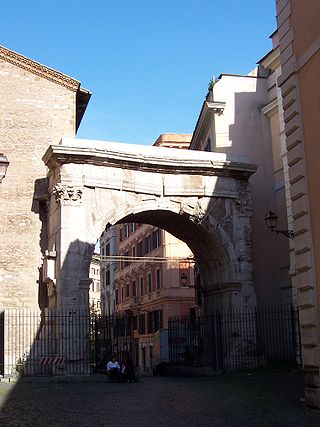
The Via Labicana was an ancient road of Italy, leading east-southeast from Rome. The course after the first six miles from Rome is not taken by any modern road, but it can be clearly traced from remains of pavement and buildings. It seems possible that the road at first led to Tusculum, was then extended to Labici, and later became a road for through traffic. As the preferred way to the southeast, the Via Labicana may even have superseded the Via Latina. The Via Labicana's summit just west of the Mount Algidus pass, calls for some 22 metres (72 ft) less of a climb overall. Beyond the two roads' reunion, the route was probably called Via Latina rather than Via Labicana.
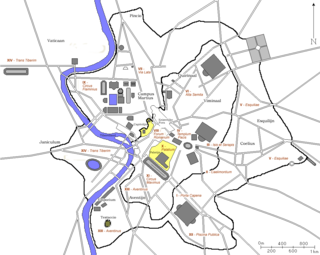
In 7 BC, Augustus divided the city of Rome into 14 administrative regions. These replaced the four regiones—or "quarters"—traditionally attributed to Servius Tullius, sixth king of Rome. They were further divided into official neighborhoods.
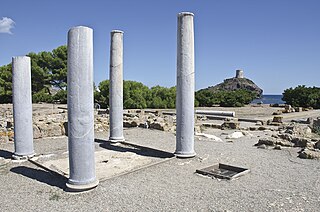
Nora is an ancient pre-Roman and Roman town on a peninsula near Pula, near to Cagliari in Sardinia.
Titus Didius was a politician and general of the Roman Republic. In 98 BC he became the first member of his family to be consul. He is credited with the restoration of the Villa Publica, and for his command in Hispania Citerior. He held two Triumphs, one for his victories over the Scordisci, another for his victories in Spain.

The Arch of Gallienus is a name given to the Porta Esquilina, an ancient Roman arch in the Servian Wall of Rome. It was here that the ancient Roman roads Via Labicana and Via Tiburtina started.

Capo Colonna is a cape in Calabria located near Crotone. In ancient Roman times the promontory was called Promunturium Lacinium. The modern name derives from the remaining column of the Temple of Hera Lacinia.

Acquarossa or Fosso Acqua Rossa is the modern name of the location of an ancient Etruscan settlement abandoned or destroyed in the second half of the sixth century BC. Located near Viterbo, in Etruria, was excavated by the Swedish Institute at Rome in the 1960s and 1970s. An elite complex similar to the Regia in Rome was excavated at the site.

The Supsa is a river in the Black Sea basin of Georgia. It has a basin of 1,130 square kilometres (440 sq mi) and flows roughly west for 108 kilometres (67 mi) until it joins the Black Sea near the village Supsa.

The Great Satraps' Revolt, or the Revolts of the Satraps, was a rebellion in the Achaemenid Empire of several satraps in western Anatolia against the authority of the Great King Artaxerxes II. The Satraps who revolted were Datames, Ariobarzanes, Orontes, Autophradates, and Mausolus. The timing of their revolts varied, as did the circumstances that induced them to rebel. Though often portrayed as a general uprising, there was little coordination among them and at no time did they actually threaten Artaxerxes directly. Their efforts were aimed at secession rather than a takeover of the Empire.
Spurius Tadius, also Ludius or Studius, was a Roman muralist of the Augustan period. His exact date of birth and death are unknown. Some manuscripts refer to him by alternate names, including Studius and Ludius.

The Porta Viminale was a gateway in the Servian Wall of ancient Rome, at the centre of the most exposed stretch of the wall between the Porta Collina and the Porta Esquilina. These three gates and the Porta Querquetulana were the oldest in the wall.

Porta Caelimontana and Porta Querquetulana were two city gates that opened in the Servian Wall in Rome (Italy); only the first one is still existing.
Bratus is the name of a tree Pliny the Elder described in his Naturalis Historia:
Book 12, chapt. 39 —THE TREE CALLED BRATUS.
Hence it is, that they import from the country of the Elymæi the wood of a tree called bratus, which is similar in appearance to a spreading cypress. Its branches are of a whitish colour, and the wood, while burning, emits a pleasant odour; it is highly spoken of by Claudius Cæsar, in his History, for its marvellous properties. He states that the Parthians sprinkle the leaves of it in their drink, that its smell closely resembles that of the cedar, and that the smoke of it is efficacious in counteracting the effects of smoke emitted by other wood. This tree grows in the countries that lie beyond the Pasitigris, in the territory of the city of Sittaca, upon Mount Zagrus.
